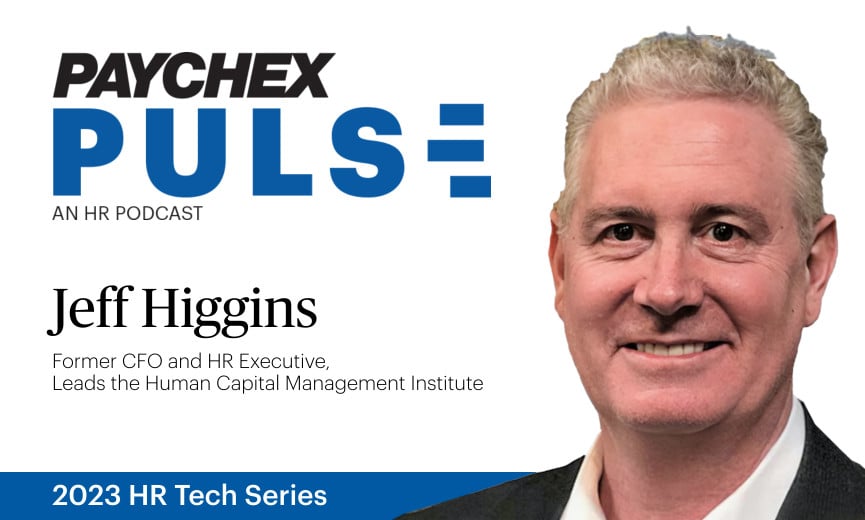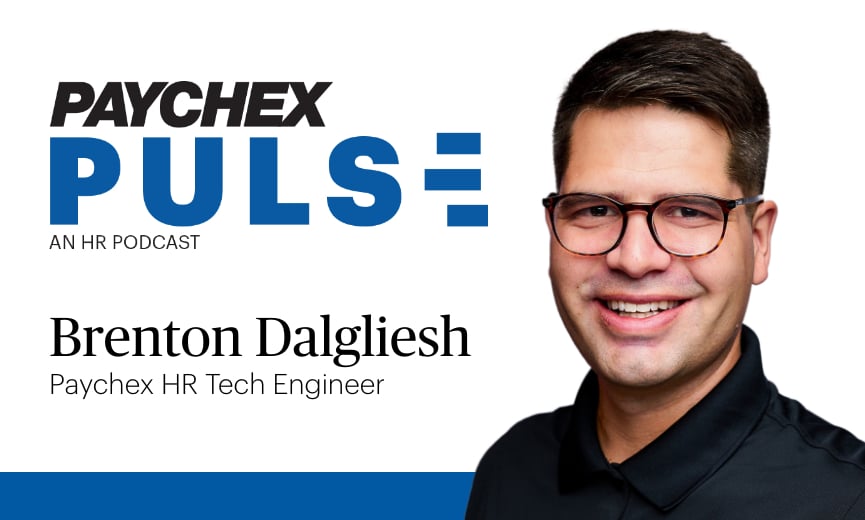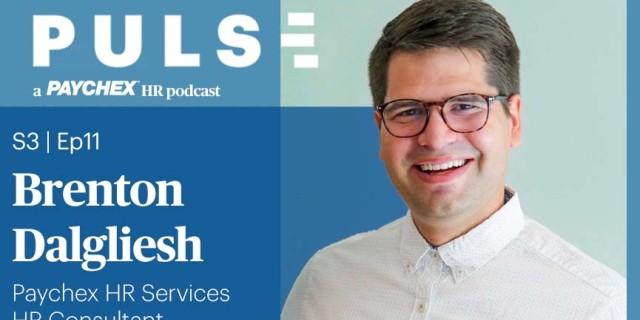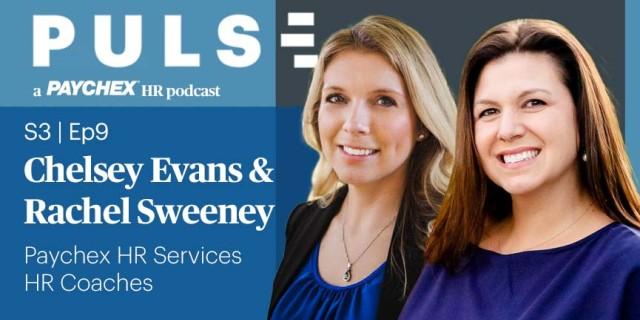Exploring the Power of HR Analytics: 2023 HR Tech Series - Part 3

Podcast •

Watch
Summary
Live from the floor of the 2023 HR Technology Conference, Jeff Higgins, Founder and CEO of the Human Capital Management Institute, joins the podcast to share his insights on data-driven decision making in HR and its implications for businesses of all sizes. Learn how to marry the qualitative aspects of softer metrics like engagement and culture with harder metrics like turnover rate or time-to-fill to uncover incredible insights about your workforce.
Topics include:
00:00 – Welcome Jeff Higgins
01:37 – Jeff’s insights from HR Tech
02:26 – Minimizing the importance of AI in HR analytics
04:17 – Getting started with HR analytics
05:10 – Developing insights using qualitative and quantitative data
07:38 – The impending regulatory impact on people analytics
10:06 – Standardizing people analytics
11:34 – An overview of The HR Analytics Bootcamp
12:56 – The future of analytics and AI
13:58 – Wrap Up
Connect with Jeff:
> LinkedIn
Make more informed HR decisions and accurate financial forecasts—enroll in Jeff’s HR Analytics Bootcamp today.
Learn how to transform raw data into actionable insights with our HR Metrics Cheat Sheet.
Start preparing now for these 2024 HR technology trends.
Paychex doesn’t just have the HR analytics you need, but the expert guidance that helps you turn them into positive changes for your business. Learn more.
View Transcript
Jeff Higgins (00:00)
Again, you know, I talk about statistics, but again you don't have to be a statistician. If you just build a trend and you say, "Wow, every time we recruit more people from this particular background, this particular university, or they've worked at this particular employer, our turnover rate goes down. Hmm. Maybe there's a pattern relation." Yeah, again, you don't have to be... In fact, I would argue some of the insights are almost a blinding flash of the obvious. You look back and you go, "We should have known that." But it was there, you just never had the data kind of in the right format lined up, maybe with a proper trend and/or some other contextual elements added to it. So, I would argue all of the pieces that you just mentioned can be converted or blended to really hard metrics to get even better insight.
Rob Parsons (00:39)
Welcome to season four of Paychex PULSE, an HR Podcast, where HR professionals can find great insights on today's top issues and be inspired to build and lead effective teams in a healthier workplace. Hi everyone. Rob Parsons here. Welcome to the Paychex PULSE podcast, live from the show floor of HR Tech 2023. And today, or right now we're joined by our good friend Jeff Higgins. Jeff is the CEO of HCMI. As a former senior HR executive, and a former CFO, Jeff is a global thought leader with 30 years of combined workforce planning, analytics, and finance experience supporting Fortune 500 companies. Jeff, welcome to the podcast.
Jeff Higgins (01:35)
Thank you, Rob. It's a pleasure to be here.
Rob Parsons (01:37)
It's so great having you, and it's great seeing you at this kind of event. Just let's start with a high-level view. You've been to the show, you've been to the sessions, you've been to the expo hall. What's your top-level takeaways? What are you seeing so far?
Jeff Higgins (01:51)
Well, what I expected to see here isn't what I'm actually seeing. I would've thought, based on all the noise in the media that there was going to be a ChatGPT or .AI on every booth, and I haven't seen that. I don't know if everybody just didn't have time to update their booths, or maybe they're still working to integrate it. I'm sure they're... Everyone's using it right? That Copilot methodology. We're actually using it in projects right now as we speak, but we don't have it fully integrated. So maybe that's kind of the interesting, I would've expected but we're not quite there yet.
Rob Parsons (02:26)
It's an interesting point. AI was certainly a lot of noise last year, and something I've been hearing from previous episodes of the podcast is it's about embedding AI. It's about bringing it into the solutions. And maybe it's not necessarily the hero, but it helps the hero act better. Something I want to dig into with you was the fact that it depends on data and data-driven decision making, no matter where I'm applying it, you know, it's certainly an area you're focused on, an area you're an expert at. With or without AI, if I want to get into people analytics, HR data, where do I want to start?
Jeff Higgins (03:06)
Yeah, great, great question. So, I'd like to take a couple of angles on that. One, just to connect the dots with AI. If you heard Josh Bersin speak, and by the way, Josh, big fan of yours overall, but I am going to respectfully disagree with you on something. He said, basically, AI is going to take over a lot of this stuff for us. AI is going to do our analytics. And I'm going to say no, it's not. Not 3.5, not 4.0, not 4.5, and not for the foreseeable future. Because human capital data is immensely complex, and we are impossibly complex. In fact, every person is unique. So, the best you can get to is, you know, pattern recognition, which of course an AI can do. But can it really differentiate, you know, groups with the right metrics, at the right levels. So, we're experimenting with it, and we find that it gets, even the latest, latest versions, It gets some really good things like, Well that's great, that's great, that's great. Ooh, that's really dumb. Oh, that's not. So, it, you know, because it doesn't know, right? If it were a former HR professional with ten years of experience, you would know that those insights were no good. So, that's one angle. The other angle is you don't have to wait for ChatGPT or any other AI to figure this all out. You could take your basic payroll data, marry it up with a couple of pieces from maybe your recruiting, or your learning, or your engagement and you can do some really amazing insights with it. But there's a few tricks, which we'll probably talk about in a minute, that you can use to get from, you know, just basic how many people left? How many people did we hire? What's our total workforce cost? To something more predictive, or even a little bit insightful as to how I might improve it. So almost, you know, predictive and prescriptive in terms of the analytics. And you don't need to be an advanced data scientist and you don't need ChatGPT to do that. You do probably need Excel, but you can do it from there.
Rob Parsons (05:10)
That's really interesting. But it's funny, the things you mentioned, and there's things I've heard about, cost of turnover, cost of a new hire, those are metrics we're aware of. I'm very hype on culture right now. Training, upskilling, getting the right people in the right place, getting my organization set up correctly. If they feel a little soft for analytics, is that the case?
Jeff Higgins (05:33)
Oh, another great question. So, they feel soft, but they're not. In fact, I just had a conversation with an expert who does a lot of consulting for companies, and they get their data, and was complaining about how messy the data is. It's not that it's all wrong, it's just very inconsistent. There's lots of blanks and things like that. Those are some of the challenges that go with the territory, why? Because every HR system and everyone does it a little differently. We don't have that, you know, that clear set of standards like GAAP accounting for HR, yet. Working on it. But some of these software things like skills, particularly like engagement and culture, you can actually marry up what I would call some of the qualitative aspects. You could take an engagement score, you could take even some of the comments, and you can do very quick integration or correlation with, like leadership, by department, by facility, turnover rate, recruiting rate, time to fill. You can marry it up with some of the harder metrics. And what you'll find is patterns. And again, you know, I talk about statistics, but again you don't have to be a statistician. If you just build a trend and you say, "Wow, every time every time we recruit more people from this particular background, this particular university or they've worked at this particular employer, our turnover rate goes down. Hmm. Maybe there's a pattern relationship." Yeah, again, you don't have to be... In fact I would argue some of the insights are almost the blinding flash of the obvious. You look back and you go "We should have known that." But it was there, you just never had the data kind of in the right format, lined up, maybe with a proper trend, and/or some other contextual elements added to it. So, I would argue all of the pieces that you just mentioned can be converted or blended to really hard metrics to get even better insight. Because the hard metrics can tell you what. Definitely what. But they won't get into the why. And that's the opportunity for the more qualitative, softer metrics to give you more of the why. And by the way, either one is really good. Neither one on a standalone basis is sufficient. So, when you marry them up, that's when you really give management the full picture. The what and the why.
Rob Parsons (07:36)
I love that. You know, as we're talking about data, something you mentioned to me a couple weeks ago is that people analytics, people data, are starting to come under some regulatory scrutiny now, aren't they?
Jeff Higgins (07:48)
Yes. Yeah, so not to go do too deep into that because I know a lot of your customers and a lot of the people watching this are smaller companies but the SEC, which actually issued rules to require companies to disclose more about their human capital, their stated most valuable asset, but they took a principles-based approach. They said, "Companies and industries, we're going to let you decide what the right metrics are. We're not sure." They didn't even define human capital.
Rob Parsons (08:15)
Ah.
Jeff Higgins (08:16)
And then fast forward six months to a year and companies didn't disclose anything new. So I think the SEC, and even more so institutional investors who were kind of the big customers of the SEC said, "Hey, that's not what was the intent. The intent was for companies to tell us more about your most valuable asset." How can you say, "Valuable asset," "People are our source of competitive advantage," "Value creation," "We love our talent," and then tell us nothing about them except when then we hear later there's some big lawsuit or some big scandal. I'm like, that is not the way we want to hear about your talent. We want to know that you're managing and mitigating risk and growing and investing in your talent, not "Oh, scandal here, but everything's okay." So, what the SEC has done is they've been, for the last two years, taking a second bite of the apple, and it could be literally as soon as this October, one of their subcommittees actually voted to officially release whatever it is they've got. I don't know, haven't seen it, but they've got something cooked up in terms of prescriptive metrics that all public listed companies are then going to be required to disclose. There'll be a comment period. But I think writing as a company to say, "We don't think you should do this," is not going to work. You could say, "I recommend another metric." So, this is going to become much more of a regulatory thing. And I think it's going to be a sea change moment for HR. It'll start with the big public listed companies, of course. But I think it will cascade, over time, into larger privately held, portfolio companies of private equity, and then ultimately small, you know, midsize even, you know, but not below a certain size, but smaller size privately held companies. And if you're a smaller company and this is something everyone else is reporting, it then becomes a, well, why wouldn't you do it too? Because it's going to give you a better level of insight and there'll be some great benchmarks out there for every company to start to compare. If you want to compare your turnover rate to your much larger competitor who has 10,000 employees, and you only have 250, you could do it.
Rob Parsons (10:06)
I never thought about the potential standardization of people analytics. I mean, we all know what goes on a balance sheet. We know all what goes in a financial statement. I mean there, you know, you mentioned earlier, GAAP. So, we know what's there. But it's not like that in the world of people analytics at all. It feels like the wild west,
Jeff Higgins (10:24)
Right, yeah. The joke when I do trainings is, and you've heard my jokes, Rob, so totally forgiven if you don't laugh, is, if people are most valuable asset where are they on the balance sheet? And the answer is nowhere. Actually, not nowhere. There may be something in the liabilities on the negative side because if we owe them any money, like accrued payroll, accrued retirement, accrued bonuses it's going to be in the negative side. Positive side, not a dollar. And then I would jokingly say, in fact, people often agree, does your laptop computer have an asset tag? Laptop computer is more valuable than a person in a really weird kind of way because it goes on the balance sheet as a positive asset. People, who basically without which the computer is meaningless, don't. And so this is a starting point. And whatever the SEC comes out with, it's just a starting point. They're going to add more to it over time. Eventually, I would imagine, companies are going to have to provide something like financial statements for people or talent that will give investors, markets, peers, and competitors in their industry, much more of a readout of what and how they manage their talent. Which fits in with ESG, fits in with sustainability really well.
Rob Parsons (11:32)
I love it. It makes such total sense. And I'm also really glad you mentioned your training, because you're working with Paychex to put together a bootcamp. An HR analytics bootcamp. Can you tell me a little bit about that?
Jeff Higgins (11:43)
Right, so no AI in the bootcamp. What it is, is if you're a CFO, or a controller, or you're an HR director, or you're an analyst for reporting, on either finance or HR side, and every month or every quarter you're downloading the payroll data. Which by the way, I'm a former CFO, that's what I used to do. I work with clients today. Guess what they're doing? They're downloading the payroll data. So, they download it and then they try to do some of this analysis and analytics on their own. The problem is they're missing a few pieces. So, what we're actually going to do in the bootcamp is we're going to give you, in three parts, three short, 45 minute segments, a little bit of secret sauce and some very, you know, step-by-step examples, like a cooking show. We'll have the food all prepped and we'll show you how to cook, how to prepare a pretty advanced, yet basic analysis to give you some really actionable insight using just payroll data for a small to mid-size company. And I think our main example company we're going to work on is about 60 employees. So, if we can do it for them, you know, you can absolutely do it, you know, kind of at home, or in your own organization by mirroring those same steps.
Rob Parsons (12:48)
That sounds like that's going to be great for people. I really appreciate you working on that for us.
Jeff Higgins (12:52)
Thank you. Al Adamson out there in the audience.
Rob Parsons (12:56)
So now, let's look ahead. Let's peer into your crystal ball. You expected to see AI everywhere this year. What do you expect to see next year?
Jeff Higgins (13:06)
Wow, that's a great question. Well, I guess I'll go with the default. I would expect to see more AI because it's not going away. It may just be a longer lead time in terms of adoption than what somebody like Josh is saying is going to happen. And I think change, you know, we can see it coming, but it takes time. I think there'll be more integration of analytics. I think the analytics and the insights because companies need it. And with the assistance of a ChatGPT-style tool set, as well as who knows what's going to come out next, are going to help facilitate that and speed that up. So, I think the bar is going to keep going up at shows like this. I think they're going to be more and more companies that have data that they're offering instead of just companies who are asking for your data.
Rob Parsons (13:48)
That's a great point. I am looking forward to seeing that. Because yes, there's a lot of people that want your data but there's not a lot of people giving the insights back.
Jeff Higgins (13:56)
Right.
Rob Parsons (13:57)
Excellent. Well, Jeff these were great insights you shared today with us. Thank you so much for coming on.
Jeff Higgins (14:03)
Thank you, as always, Rob. It's a pleasure.
Rob Parsons (14:05)
And I want to thank our listeners as well. Don't forget to check out Jeff's HR analytics bootcamp brought to you by Paychex. You can find it at payx.me/bootcamp. That's payx.me/bootcamp. And you can also find a link in our show notes. And as always, please stay happy and healthy. Be sure to subscribe to this and our Paychex Thrive Business podcast on your favorite podcast platform. Looking for more ways to keep your finger on the pulse of industry dynamics? Visit our resource center for the latest research, thought leadership, and news at paychex.com/worx. That's W-O-R-X. Thanks again for joining us. Until next time, please stay happy and healthy.
Announcer (14:55)
This podcast is property of Paychex Incorporated, 2023. All rights reserved.

 Apple Podcast
Apple Podcast Spotify
Spotify iHeartRadio
iHeartRadio









